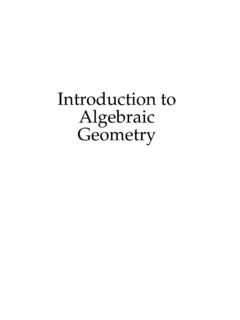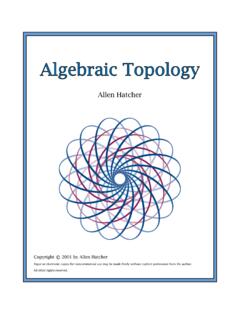Transcription of Algebraic Thinking: A Problem Solving Approach - ed
1 L. Sparrow, B. Kissane, & C. Hurst (Eds.), Shaping the future of mathematics education: Proceedings of the 33rd annual conference of the Mathematics Education Research Group of Australasia. Fremantle: MERGA. 665 Algebraic Thinking: A Problem Solving Approach Will Windsor Griffith University Algebraic thinking is a crucial and fundamental element of mathematical thinking and reasoning. It initially involves recognising patterns and general mathematical relationships among numbers, objects and geometric shapes. This paper will highlight how the ability to think algebraically might support a deeper and more useful knowledge, not only of algebra, but the thinking required to successfully use mathematics. The paper will highlight how a deeper analysis of mathematical problems can instigate student discourse, providing meaningful experiences that can developing Algebraic thinking.
2 Recent calls for reform in mathematics education in Australia have focused on the need to promote and facilitate improved teaching and learning of mathematics (Council of Australian Governments, 2008; National Curriculum Board, 2008). A key element of this reform agenda is the introduction of a national mathematics curriculum. The strand Number and Algebra will be an integral part of the new curriculum with the middle and upper primary years emphasising an Algebraic perspective of number rather than the formal algebra familiar to most people. In contrast, secondary school students will undertake the study of formal algebra having been introduced to Algebraic concepts and ideas at the primary school level. The Algebraic perspective I attempt to illustrate is a perspective that values, enriches and improves the thinking required to understand Algebraic concepts.
3 Consequently, in this discussion we will adopt the term Algebraic thinking rather than an Algebraic perspective of number, as it takes into account the variety of activities students can engage in across all mathematics strands, not simply number. Algebraic thinking is founded on numeracy and computational proficiency, the reasoning of geometry and skills associated with measurement- concepts introduced and taught in the primary and middle school (Kaput, 2008). Importantly, it extends the thinking required to solve problems beyond methods tied to concrete situations. In time, this thinking supports students ability to Problem solve using abstractions and to operate on mathematical entities logically and independently from the material world. The Approach that I propose involves identifying and using mathematical problems that promote and advance a generalised perspective of mathematical Problem Solving .
4 An ability to consider problems from this perspective can allow individuals to acquire adaptable ways of thinking, to express the generalisations they have arrived at and leads into a meaningful use of Algebraic symbolism (Carraher, Brizuela, & Schliemann, 2003). The potential value for using Problem Solving contexts is that it may broaden and develop students mathematical thinking and provide them with an impetus for understanding a greater collection of problems of increasing complexity and mathematical abstraction (Kaput, 2008; Kaput, Blanton, & Moreno, 2008; Schliemann, Carraher, & Brizuela, 2007; Lins, Rojano, Bell, & Sutherland, 2001). As will become apparent, Algebraic thinking promotes a particular way of interpreting mathematics. It extends the mathematical thinking of students by encouraging them to interact and engage with the generalities and relationships inherent in mathematics.
5 Lins et al (2001, p. 3) contend that no matter how suggestively Algebraic a Problem seems to be, it is not until the solver actually engages in its solution that the nature of the thinking comes to life. 666 Problem Solving and Algebraic Thinking Using mathematical problems has been advocated as a crucial and motivating component of learning and understanding mathematics. Schoenfeld (1992) notes that, when Solving mathematical problems, students develop a deeper understanding of mathematics because it helps them to conceptualise the mathematics being learnt. Stanic and Kilpatrick s (1989) review of Problem Solving indicates that historically, mathematical Problem Solving has been instrumental in achieving a variety of goals within the mathematics curriculum. Furthermore, productive Problem Solving experiences that move children beyond the routine acquisition of isolated techniques are fundamental in developing higher order mathematical thinking and reasoning (Booker & Bond, 2009; Polya, 1973).
6 In my view, many of the fundamental ideas on which mathematics is built can make sense to children if those concepts are viewed in meaningful and challenging contexts. In the book How to Solve It (1973) Polya is explicit in characterising the heuristics of effective Problem Solving . Essentially, he attempts to understand how people think and the strategies they might use when Solving problems. Polya (1973) contends that to solve any Problem , the characteristics and properties of the Problem should be analysed. Once the Problem is understood then a plan is devised and strategies are implemented and finally, opportunities to reflect upon the solution are required. Though Polya emphasises the heuristics of Problem Solving , he also acknowledges the idea of mathematical connectedness and generality, key components of Algebraic thinking.
7 He suggests that by actively engaging with problems students can develop the ability to understand the generalities associated with Problem Solving : In Solving a Problem of one or the other kind, we have to rely on our experience with similar problems and we often ask the questions: Have we seen this Problem in a slightly different form? Do we know a related Problem ? (Polya, 1973, p. 151) This brief overview of Polya s work serves to emphasise that the generalities, relationships and interconnectedness that underpins mathematics can be carried through to developing Algebraic thinking. Furthermore, being aware of and having the capacity to consider, ascertain and communicate the generalities of a particular Problem may invariably enhance an understanding of formal algebra. As Krutetskii (1976, pp. 334-335) observed one must be able to see a similar situation (where to apply it), and one must master the generalised type of a solution, the generalised scheme of a proof or of an argument (what to apply).
8 This perspective appreciates that Algebraic thinking and Problem Solving are inextricably linked by common skills and mathematical understandings. In shifting the emphasis of Problem Solving , from simply finding a specific answer to also including a focus on Algebraic thinking, I conjecture that it may provide a powerful way to teach and learn Algebraic ideas. Many of the problems found in elementary arithmetic and geometry have the capacity to support a way of thinking that connects a range of mathematical content and processes (Booker, Bond, Sparrow, & Swan, 2010; Bednarz & Janvier, 1996). Extending mathematical problems Solving to include the developing Algebraic thinking, educators can facilitate more divergent and adaptive ways of thinking mathematically. Opportunities arise to engage and extend students mathematical experiences that go beyond routine arithmetical solutions.
9 As Silver, Ghousseini, Gosen, Charalambous, and Strawhun (2005, p. 288) observed, when discussing the advantages of facilitating a variety of different solutions: 667 An aphorism of unknown origins captures the essence of this idea: You can learn more from Solving one Problem in many different ways than you can from Solving many different problems, each in only one way . Developing Algebraic Thinking Using Problem Solving Teaching Algebraic thinking using a Problem Solving Approach can be established amid the learning experiences that already exist in most classrooms. It is apparent that this Approach evolves and builds upon a child s ability to consider, see and think about the mathematical concepts within a Problem . Lee s (2001) analysis of Algebraic thinking highlights some of the underlying strategies which characterise this type of mathematical reasoning.
10 She observes that when children analyse problems from an Algebraic thinking perspective they may consider: - Reasoning about patterns (in graphs, number patterns, shapes, etc) stressing and ignoring, detecting sameness and difference, repletion and order. - Generalising or thinking in terms of the general, seeing the general in the particular; - Mentally handling the as-yet-unknown, inverting and reversing operations; - Thinking about mathematical relations rather than mathematical objects. It is apparent that the development of Algebraic thinking arises from generalising mathematical thought. Researchers such as Bednarz, Kieran, and Lee (1996) extend this idea and state the process of generalisation as an Approach to algebra appears ultimately related to that of justification . Thus, a classroom environment that values and promotes collaborative learning situations, student discourse and the opportunities to communicate mathematical ideas and conjectures can better facilitate Algebraic thinking.














